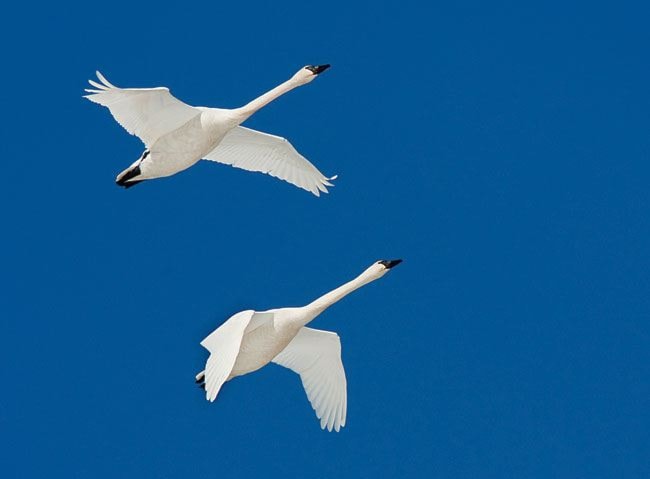It’s as sure a sign of spring as any: the reappearance of one of the world’s most graceful and elegant birds, the swan, to M’Clintock Bay on Marsh Lake.
Not that they’re usually striking a particularly elegant pose. More often than not, they’re floating bottoms-up, legs aflutter, as they uproot pondweed from the lake bottom.
The sedges that swans love have starchy roots. The birds are carbo-loading, like marathon runners before a big race.
Some have flown up from BC’s Lower Mainland. Others have wintered in Alberta or in Idaho, Montana and Wyoming. Most will nest in Alaska.
But before they do, they’ll typically spend 10 days at Marsh Lake, fattening up.
On Tuesday, 77 trumpeter swans were spotted from the Government of Yukon’s Swan Haven observation post, which opens each April. It’s a decent number for this time of year, said biologist Bruce Bennett, but it’s low compared to last year’s spectacular showing, which resulted in a record 2,432 swans spotted at the peak of April 7.
“It just totally blew everything out of the water,” said Bennett.
Last year’s confluence of swans was the result of the right weather conditions. Ice had disappeared across northern British Columbia, so swans kept flying north until they hit the Yukon, which was still largely ice-locked, save for the warm waters at Swan Haven.
This year’s different. Many lakes remain frozen across northern BC, so the swans are “just beginning to trickle in.”
Ice still covers much of M’Clintock Bay, too, so the birds remain white specks from Swan Haven, unless you’re peering through one of the viewing scopes that have been set up for visitors. Thankfully, much of the snow has melted, making it easy to follow a path that offers a closer view of the birds.
For now, photographers will probably have better luck parking near the Tagish bridge and tromping to the riverside.
The warm waters of Marsh lake keep M’Clintock Bay ice-free for much of the year. That, combined with an abundance of food and enough space to provide protection from predators, makes the location the most important pit-stop for swans in the southern Yukon.
Swan Haven’s peak number of swans used to be around April 23. But swans have lately appeared earlier. Bennett is betting that this year’s peak will be April 14.
“We’ll find out how badly out I am,” he said with a chuckle.
Trumpeter swans are North America’s largest bird, and the world’s largest waterfowl. They have wingspans of up to 2.5 metres, and they can weigh upwards of 10 kilograms.
There’s believed to be 46,000 trumpeter swans across North America today. Their numbers have exploded for the past three decades, after the birds were nearly hunted to extinction in the late 18th century.
Swan skins were valued at the time for making women’s powder puffs in Europe, while the bird’s feathers adorned fashionable hats.
The birds have also long been sought after by Yukon’s First Nation people. But their traditional hunts have never seemed to make much of a dent in swan numbers.
Tundra swans also frequent Swan Haven, but not in as many numbers as the trumpeters. They usually begin arriving by mid-April.
It isn’t easy to tell trumpeter and tundra swans apart. Both have white feathers and black beaks.
But a seasoned birdwatcher is able to spot the differences between the two: trumpeters are bigger, sport flashes of red on their lower jaws, have straighter beaks and honk like the musical instrument that’s their namesake; tundras are smaller, often wear a teardrop-shaped splash of yellow beneath their eyes, have curved beaks and emit a higher, squeakier honk.
But it’s probably easier to tell the species apart by their calls. A trumpeter’s call is, like its name suggests, sonorous and trumpet-like. A tundra swan’s call is high-pitched and quavering, like a Canada goose.
It’s also possible to tell the birds apart by how they fly, said Bennett. Trumpeters tend to fly low, close to the trees. Tundras fly much higher in the air, and spend a long time spiraling to the ground.
Marsh Lake’s swans are typically accompanied by a variety of ducks, who eat the swan’s leftover pondweed. Smaller birds are unable to uproot the plants themselves. Swans also stir-up fresh-water shrimp and other bugs, which the ducks devour.
On Tuesday, Swan Haven biologists spotted 110 ducks, including goldeneyes, mergansers, buffleheads, mallards and three redheads.
Other spring birds spotted include a merlin falcon and purple finch.
Yukon’s annual Celebration of Swans starts on April 16 and continues until the end of the month. New events this year include an outdoor service by Rev. Bev Brazier and the Whitehorse United Church on April 25 and an April 17 presentation of live predators by Dr. Hart from the American Bald Eagle Foundation, who will show two owls and a hawk from Haines.
Swan Haven is open weekdays from 5 p.m. until 9 p.m. and weekends and holidays from noon until 7 p.m.
Contact John Thompson at
johnt@yukon-news.com.
